hotrod jigs
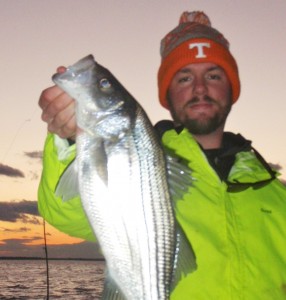 “One last drift,” I called up. My son was casting from the bow while I piloted the boat. It was getting dark and we had New Year’s Eve dinner plans in Annapolis, so we had to go. The better fish were holding in a warm water pyconocline; a spot no bigger than a pickup truck bed, 40-feet deep. I pointed the bow of my 27 Judge CC into the swift current and idled us into a position just downstream from the rocky corner. Daniel compensated for the strong flow and launched his hotrodded chartreuse BKD toward an imaginary spot 20-yards upstream from where he wanted his lure to touch the bottom. In water this swift, he’d be lucky if his jig bumped the rocks three times before it drifted downstream out of the strike zone. A successful cast either caught a fish, or brought up a clump of the brown bryzoan moss that covers the bottom. The only other option was to hang up. He brought his elbows together beneath the low-profile baitcaster and followed the arc of his line with his extra-fast rod tip as he anticipated the slight bump that would tell him his lure had touched the rocks.
“One last drift,” I called up. My son was casting from the bow while I piloted the boat. It was getting dark and we had New Year’s Eve dinner plans in Annapolis, so we had to go. The better fish were holding in a warm water pyconocline; a spot no bigger than a pickup truck bed, 40-feet deep. I pointed the bow of my 27 Judge CC into the swift current and idled us into a position just downstream from the rocky corner. Daniel compensated for the strong flow and launched his hotrodded chartreuse BKD toward an imaginary spot 20-yards upstream from where he wanted his lure to touch the bottom. In water this swift, he’d be lucky if his jig bumped the rocks three times before it drifted downstream out of the strike zone. A successful cast either caught a fish, or brought up a clump of the brown bryzoan moss that covers the bottom. The only other option was to hang up. He brought his elbows together beneath the low-profile baitcaster and followed the arc of his line with his extra-fast rod tip as he anticipated the slight bump that would tell him his lure had touched the rocks.
Bump. There it was. A quick snap of the wrist picked the jig back up before it had time to snag on the bottom. Again, he followed the line with his rod tip and waited for the bump as the lure fell. Watching the drop. Anticipating. Any moment now. Slam! Daniel set the hook and fought another 24-inch football-shaped striper to the side of the boat. That made seventeen in 90 minutes – a fun evening of catch & release fishing very close to home. Read More!
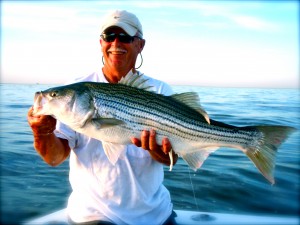 The good news is that those migratory fish I talked about last week – you know, the ones that sneak in through the C&D canal every October – well, they’re here. Since last Tuesday, reports of big, clean fish with sea lice have been flooding in. The bad news is that the Upper Chesapeake Bay is still so murky that those big stripers are moving quickly down the channel searching for cleaner water and more plentiful bait fish. They haven’t gone too far south, but they have bypassed the northern humps and ledges where we’ve found them in years past. The ugly part is that, since those fish showed up in some very accessible high-traffic areas, word got out quickly and a bite that traditionally lasts until the end of October shut down in just a few days. At the end of last week, fishing was very good, but soon hoards of inexperienced fishermen, some with screaming kids, running engines, and blaring radios, descended on an area that is shorter and narrower than a football field. That caused the fish to hunker down and become very difficult to catch. Difficult, but not impossible. It’s been a tough week, but there are trophy stripers in our area right now, and fishing is sure to improve as more and more migratory fish enter the Chesapeake.
The good news is that those migratory fish I talked about last week – you know, the ones that sneak in through the C&D canal every October – well, they’re here. Since last Tuesday, reports of big, clean fish with sea lice have been flooding in. The bad news is that the Upper Chesapeake Bay is still so murky that those big stripers are moving quickly down the channel searching for cleaner water and more plentiful bait fish. They haven’t gone too far south, but they have bypassed the northern humps and ledges where we’ve found them in years past. The ugly part is that, since those fish showed up in some very accessible high-traffic areas, word got out quickly and a bite that traditionally lasts until the end of October shut down in just a few days. At the end of last week, fishing was very good, but soon hoards of inexperienced fishermen, some with screaming kids, running engines, and blaring radios, descended on an area that is shorter and narrower than a football field. That caused the fish to hunker down and become very difficult to catch. Difficult, but not impossible. It’s been a tough week, but there are trophy stripers in our area right now, and fishing is sure to improve as more and more migratory fish enter the Chesapeake.
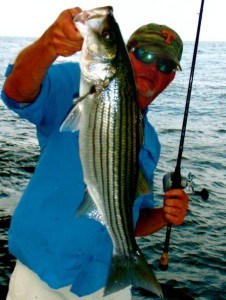 Okay, so this entry might be a little heavy on the fireworks and light on the rockfish. That’s because I’m not too good at fishing in crowds, so I spent most of last weekend doing chores around the house. That’s not to say I didn’t get some time in on the water. In fact, I don’t think I missed a day, but most of my time on Thunder Road was spent cruising to fireworks shows around Kent Island. Since this is a fishing website, I’ll start with a catching report. I met Rich at Sandy Point State Park Friday afternoon for a few minutes of piling picking onboard his 19′ Sea Hunt center console. There was very little wind but plenty of boat wakes, so we took our time getting to the our fishing spots. We had a ripping outgoing current so we rigged up soft plastic lures on three-quarter ounce jig heads. I was throwing a hotrodded white 6″ BKD and Rich had on some kind of chartreuse lure I didn’t recognize. I think we caught keeper size stripers on our first four casts, so we could have had a 5-minute limit. We stayed with it for two and a half hours and released 27 keepers with plenty of shorts. We caught on both the east and west sides of the bridge, even sneaking in downstream of some bored-looking live-liners who didn’t seem to share our amusement when we pulled nice fish right out from under the pilings where they were anchored. Read More!
Okay, so this entry might be a little heavy on the fireworks and light on the rockfish. That’s because I’m not too good at fishing in crowds, so I spent most of last weekend doing chores around the house. That’s not to say I didn’t get some time in on the water. In fact, I don’t think I missed a day, but most of my time on Thunder Road was spent cruising to fireworks shows around Kent Island. Since this is a fishing website, I’ll start with a catching report. I met Rich at Sandy Point State Park Friday afternoon for a few minutes of piling picking onboard his 19′ Sea Hunt center console. There was very little wind but plenty of boat wakes, so we took our time getting to the our fishing spots. We had a ripping outgoing current so we rigged up soft plastic lures on three-quarter ounce jig heads. I was throwing a hotrodded white 6″ BKD and Rich had on some kind of chartreuse lure I didn’t recognize. I think we caught keeper size stripers on our first four casts, so we could have had a 5-minute limit. We stayed with it for two and a half hours and released 27 keepers with plenty of shorts. We caught on both the east and west sides of the bridge, even sneaking in downstream of some bored-looking live-liners who didn’t seem to share our amusement when we pulled nice fish right out from under the pilings where they were anchored. Read More!
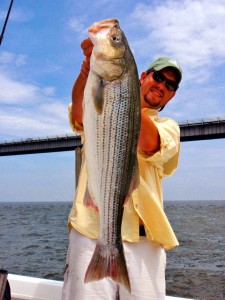 Have you heard? Light tackle casting is producing big fish lately on the Chesapeake Bay. Some lucky anglers are catching fish over 30-inches on almost every trip. Sometimes they get three or four. Most of the fish I’m catching are coming off cover like rocks or bridge pilings, but some have been hooked while fishing submerged structure in open water. Both soft plastics and metal jigs are producing. If you’ve been out, I hope you’re enjoying some lucky days. 30-inch plus stripers in late June is something to celebrate, especially considering how tough fishing has been previously.
Have you heard? Light tackle casting is producing big fish lately on the Chesapeake Bay. Some lucky anglers are catching fish over 30-inches on almost every trip. Sometimes they get three or four. Most of the fish I’m catching are coming off cover like rocks or bridge pilings, but some have been hooked while fishing submerged structure in open water. Both soft plastics and metal jigs are producing. If you’ve been out, I hope you’re enjoying some lucky days. 30-inch plus stripers in late June is something to celebrate, especially considering how tough fishing has been previously.
In my opinion, seasoned anglers make a lot of their own luck. Since the fish are more inclined to bite now, I thought it might be worthwhile to discuss tips for hooking and landing bigger fish – just some little things that can move fishermen up from the usual summer schoolies to true summer trophies. You probably have a few tips as well, so feel free to share them in the comments section. I’ll start with the basics: Read More!
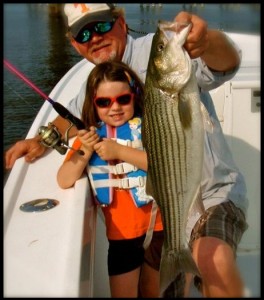 I recently found some old pictures of myself in diapers, standing beside a small wooden boat parked in front of a Tennessee farmhouse. Towering above me was my father, and at my bare feet was a nice stringer of fat largemouth bass. Did I catch them? Probably not, but like any good fisherman, I’ll happily take the credit. I might even tell you a tall tale about how – at the ripe old age of two – I tricked them into biting a lure that I hand carved from a boar’s tusk with a Bowie knife, and how they pulled harder than a Smoky Mountain mule.
I recently found some old pictures of myself in diapers, standing beside a small wooden boat parked in front of a Tennessee farmhouse. Towering above me was my father, and at my bare feet was a nice stringer of fat largemouth bass. Did I catch them? Probably not, but like any good fisherman, I’ll happily take the credit. I might even tell you a tall tale about how – at the ripe old age of two – I tricked them into biting a lure that I hand carved from a boar’s tusk with a Bowie knife, and how they pulled harder than a Smoky Mountain mule.
There’s no doubt that I owe much of what I know about fishing to my father. There’s nothing better than fishing with family. All three of my sons have become first-class fishermen. This week I’ve been fishing with my family’s next generation of anglers. I’ve had a great time on the water with my son Daniel and my granddaughter Ella. I’m happy to report that Chesapeake Bay salinity levels are finally climbing back toward normal levels (see chart below), although they’re still low. Since conditions are stablizing, striped bass fishing is getting a little more reliable. That isn’t to say some days aren’t better than others, but we’re at the point where I at least think we can count on a few fish on any given outing.
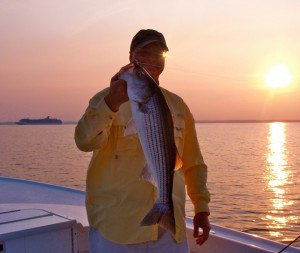 Channel catfish at Hackett’s Bar, carp at the Bay Bridge, snakeheads in St. Jerome’s Creek, and very few stripers in their usual haunts around Kent Island – what’s up with all this late-spring craziness in the Chesapeake Bay? Most fishermen are blaming salt, or more specifically, a lack thereof. Very wet weather in the Susquehanna River watershed has meant lots of fresh water entering the Bay. It’s highly unusual for the Bay to be this fresh in June. Some stations are reporting the lowest readings in recorded history. Salinity is expressed in parts per thousand (ppt), in other words, the number of grams of dissolved salts present in 1,000 grams of water. The water in the Atlantic Ocean is about 35 ppt. Surface salinity today at the Gooses Reef Buoy in the Mid-Chesapeake Bay is 2.0 ppt. That’s low! For better striped bass fishing, we need more salt.
Channel catfish at Hackett’s Bar, carp at the Bay Bridge, snakeheads in St. Jerome’s Creek, and very few stripers in their usual haunts around Kent Island – what’s up with all this late-spring craziness in the Chesapeake Bay? Most fishermen are blaming salt, or more specifically, a lack thereof. Very wet weather in the Susquehanna River watershed has meant lots of fresh water entering the Bay. It’s highly unusual for the Bay to be this fresh in June. Some stations are reporting the lowest readings in recorded history. Salinity is expressed in parts per thousand (ppt), in other words, the number of grams of dissolved salts present in 1,000 grams of water. The water in the Atlantic Ocean is about 35 ppt. Surface salinity today at the Gooses Reef Buoy in the Mid-Chesapeake Bay is 2.0 ppt. That’s low! For better striped bass fishing, we need more salt.
Fishermen have long recognized the importance of locating comfort zones where fish prefer to stay, but sometimes that isn’t so easy. Fishing in late May and early June is usually a challenge, but low salinity levels have made it especially difficult this year. Complicating the matter is that he water can be a lot saltier on the bottom of the Bay than it is on top this time of year. Since, in addition to surface observations, The Gooses Reef Buoy also provides salinity readings from the bottom of the Bay, we can see that it’s currently 7.1 ppt. That’s over three times saltier than it is on the surface. Read More!


